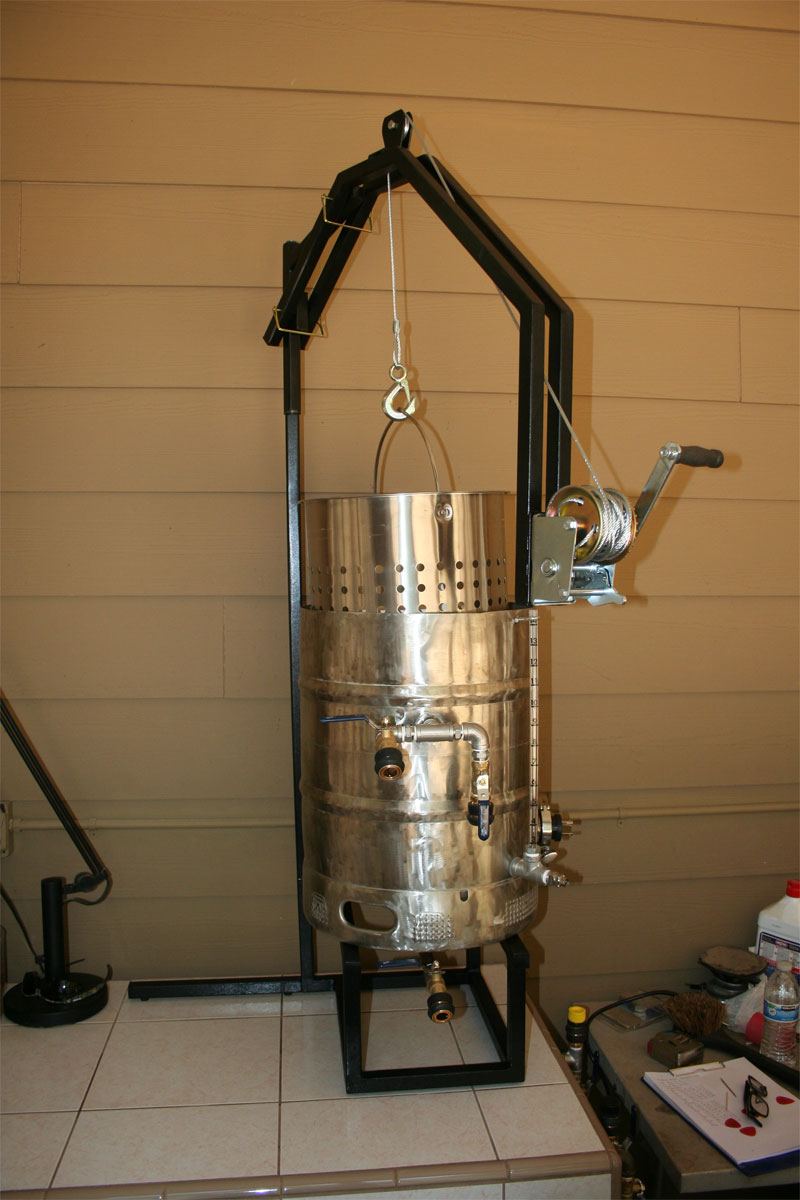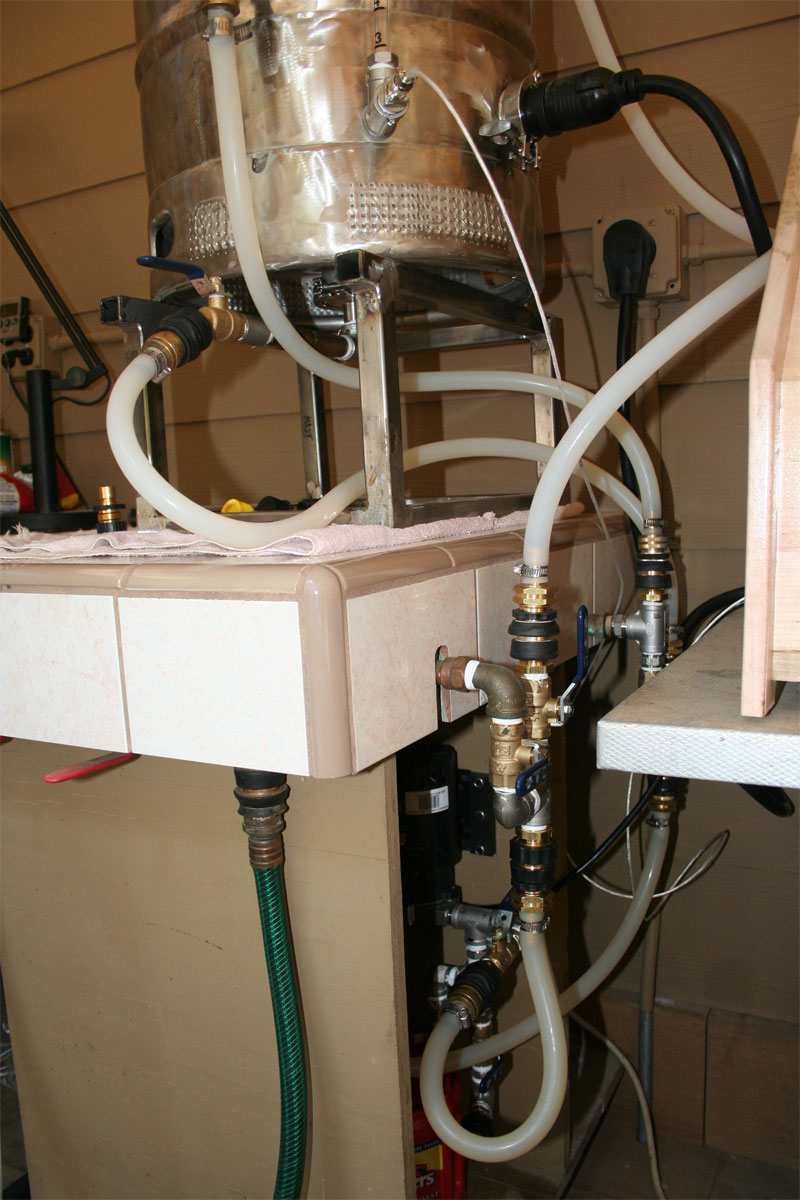r8rphan
Well-Known Member
Hi, I'm almost done with my new brewery build which can be seen in my BUILD THREAD..
Anyways, It's a single vessel, Electric BIAB system with recirculation during Mash and cooling...
I am at the point where I need to set up the mash basket and associated plumbing, and have some ideas running through my head, but need to get advice as to feasibility, some ideas for problem solving, and success/horror stories of others who have gone down this path before me...
Essentially, I have a crane that will lower a Bayou Classic basket with a bag full of grains in it, down into the keggle for the mash.. A pump is fed from the bottom of the keggle and sent back up to the top of the keggle through 1/2" silicone tubing to the mash grain basket...
So I need to decide how I want to return the wort to the grains during mash, and how to rinse them afterwards to get as much of the sugars from them as possible..
What I was originally planning on doing was to build a COFI tube from 1/2" copper tube and drilling holes in it, but I have been trying to figure out how to incorporate that into a basket mount that will support the basket if the crane is detached.. I want to support it by hanging it on the top of the keggle, but I'd like to make it so that it is easily removable allowing the basket to slide all the way down into the keggle during storage once the heating element is removed.. That will allow me to store pretty much everything (keggle support stand, pump, hoses, heater element, etc.) in the keggle, and put it under my brew stand/counter when not in use..
I'm visualizing some sort of spider that the COFI tube mounts to, that sits on the keggle rim, and the basket hangs from the spider in 3 or 4 places (maybe with SS screw eyes sticking up from the rim of the basket, and the spider legs sliding though them)
So, I am looking for pros and cons of the COFI tube method, examples of those who have made their own, any hybrids, and experiences with them...
Secondly, I was originally planning to slowly raise the grains and allow the pump to keep recirculating through the grains as a rinse step, but then I got to thinking, would not it be better to just run the fresh make up water through them while the basket is raised out of the wort to rinse the grains?
If so, would I want to use the COFI tube for this too, or would I want to switch to something else that is more like a shower head to hit the entire top of the grain bed and let it drain down through the grains?
Also, I have a tankless water heater for my house, and it is set to 145 degrees, so the hottest I could run through there as fresh water is about 130-135 degrees (the temp by the time it hits point of use).. This is far short of the 165-170 degrees that is typically used for the rinse step in a traditional mash/rinse set up (like my old mash tun/cooler).. Is that a problem? Or would cold water be a better thing to use to rinse it with?
Or there any benefit in doing this at all?
How is the rinse phase of mashing typically accomplished in BIAB systems?
Anyways, I have to come up with a plan to start working towards pretty much 'now'.. so any and all help is appreciated...

Anyways, It's a single vessel, Electric BIAB system with recirculation during Mash and cooling...
I am at the point where I need to set up the mash basket and associated plumbing, and have some ideas running through my head, but need to get advice as to feasibility, some ideas for problem solving, and success/horror stories of others who have gone down this path before me...
Essentially, I have a crane that will lower a Bayou Classic basket with a bag full of grains in it, down into the keggle for the mash.. A pump is fed from the bottom of the keggle and sent back up to the top of the keggle through 1/2" silicone tubing to the mash grain basket...
So I need to decide how I want to return the wort to the grains during mash, and how to rinse them afterwards to get as much of the sugars from them as possible..
What I was originally planning on doing was to build a COFI tube from 1/2" copper tube and drilling holes in it, but I have been trying to figure out how to incorporate that into a basket mount that will support the basket if the crane is detached.. I want to support it by hanging it on the top of the keggle, but I'd like to make it so that it is easily removable allowing the basket to slide all the way down into the keggle during storage once the heating element is removed.. That will allow me to store pretty much everything (keggle support stand, pump, hoses, heater element, etc.) in the keggle, and put it under my brew stand/counter when not in use..
I'm visualizing some sort of spider that the COFI tube mounts to, that sits on the keggle rim, and the basket hangs from the spider in 3 or 4 places (maybe with SS screw eyes sticking up from the rim of the basket, and the spider legs sliding though them)
So, I am looking for pros and cons of the COFI tube method, examples of those who have made their own, any hybrids, and experiences with them...
Secondly, I was originally planning to slowly raise the grains and allow the pump to keep recirculating through the grains as a rinse step, but then I got to thinking, would not it be better to just run the fresh make up water through them while the basket is raised out of the wort to rinse the grains?
If so, would I want to use the COFI tube for this too, or would I want to switch to something else that is more like a shower head to hit the entire top of the grain bed and let it drain down through the grains?
Also, I have a tankless water heater for my house, and it is set to 145 degrees, so the hottest I could run through there as fresh water is about 130-135 degrees (the temp by the time it hits point of use).. This is far short of the 165-170 degrees that is typically used for the rinse step in a traditional mash/rinse set up (like my old mash tun/cooler).. Is that a problem? Or would cold water be a better thing to use to rinse it with?
Or there any benefit in doing this at all?
How is the rinse phase of mashing typically accomplished in BIAB systems?
Anyways, I have to come up with a plan to start working towards pretty much 'now'.. so any and all help is appreciated...








